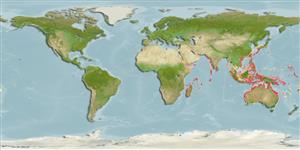Common names from other countries
Classification / Names / Names
Nomi Comuni | Sinonimi | Catalog of Fishes (gen., sp.) | ITIS | CoL | WoRMS
Environment: milieu / climate zone / depth range / distribution range
Ecologia
; salmastro. Tropical
Indo-West Pacific.
Length at first maturity / Size / Peso / Age
Maturity: Lm ? range ? - ? cm Max length : 0.4 cm SHH maschio/sesso non determinato; (Ref. 125855)
Found under stones on mud (Ref. 75835). Members of the family Iravadiidae bury in soft mud or sediments where they extract organic materials (Ref. 107294).
Life cycle and mating behavior
Maturità | Riproduzione | Deposizione | Uova | Fecundity | Larve
Members of the order Littorinimorpha are mostly simultaneous hermaphrodites.
The Academy of Natural Sciences. 2006. (Ref. 3204)
IUCN Red List Status (Ref. 130435)
CITES status (Ref. 108899)
Not Evaluated
Not Evaluated
Threat to humans
Harmless
Human uses
| FishSource |
Strumenti
Informazioni ulteriori
Age/SizeAccrescimentoLength-weightLength-lengthMorfologiaLarveAbbondanza
Fonti Internet
Estimates based on models
Preferred temperature
(Ref.
115969): 23.3 - 25, mean 24.5 (based on 51 cells).
